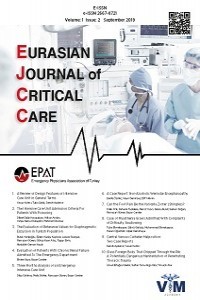The Intensive Care Unit Admission Criteria For Patients With Poisoning
The Intensive Care Unit Admission Criteria For Patients With Poisoning
Poisoning, Intensive Care,
___
- 1- Persson HE, Sjöberg GK, Haines JA, Pronczuk de Garbino J. Poisoning severity score. Grading of acute poisoning. J Toxicol Clin Toxicol. 1998;36(3):205-13.
- 2- Van den Oever HLA, Van Dam M, Van 't Riet E, Jansman FGA. Clinical parameters that predict the need for medium or intensive care admission in intentional drug overdose patients: A retrospective cohort study. J Crit Care. 2017 Feb;37:156-161. doi: 10.1016/j.jcrc.2016.09.020. Epub 2016 Sep 28.
- 3- Banderas-Bravo ME, Arias-Verdú MD, Macías-Guarasa I, Aguilar-Alonso E, Castillo-Lorente E, Pérez-Costillas L, Gutierrez-Rodriguez R, Quesada-García G, Rivera-Fernández R. Patients Admitted to Three Spanish Intensive Care Units for Poisoning: Type of Poisoning, Mortality, and Functioning of Prognostic Scores Commonly Used. Biomed Res Int. 2017;2017:5261264. doi: 10.1155/2017/5261264. Epub 2017 Mar 28.
- 4- Meulendijks CF, Van den Berg EJ, Fortuyn HD, Verkes RJ, Van der Wilt GJ, Kramers C. Predicting the need for hospital admission in patients with intentional drug overdose. Neth J Med. 2003 May;61(5):164-7.
- 5- Brett AS, Rothschild N, Gray R, Perry M. Predicting the clinical course in intentional drug overdose. Implications for use of the intensive care unit. Arch Intern Med. 1987 Jan;147(1):133-7.
- 6- Guidelines for intensive care unit admission, discharge, and triage. Task Force of the American College of Critical Care Medicine, Society of Critical Care Medicine. Crit Care Med. 1999 Mar;27(3):633-8.
- 7- Alizadeh AM, Hassanian-Moghaddam H, Shadnia S, Zamani N, Mehrpour O. Simplified acute physiology score II/acute physiology and chronic health evaluation II and prediction of the mortality and later development of complications in poisoned patients admitted to intensive care unit. Basic Clin. Pharmacol Toxicol. 2014 Sep;115(3):297-300. doi: 10.1111/bcpt.12210. Epub 2014 Mar 6.
- 8- Eizadi Mood N, Sabzghabaee AM, Khalili-Dehkordi Z. Applicability of different scoring systems in outcome prediction of patients with mixed drug poisoning-induced coma. Indian J Anaesth. 2011 Nov;55(6):599-604. doi:10.4103/0019-5049.90616.
- 9- Lam SM, Lau AC, Yan WW. Over 8 years experience on severe acute poisoning requiring intensive care in Hong Kong, China. Hum Exp Toxicol. 2010 Sep;29(9):757-65. doi:10.1177/0960327110361753. Epub 2010 Feb 9.
- 10- McMahon A, Brohan J, Donnelly M, Fitzpatrick GJ. Characteristics of patients admitted to the intensive care unit following self-poisoning and their impact on resource utilisation. Ir J Med Sci. 2014 Sep;183(3):391-5. doi: 10.1007/s11845-013-1026-7. Epub 2013 Oct 8.
- 11- Novack V, Jotkowitz A, Delgado J, Novack L, Elbaz G, Shleyfer E, Barski L, Porath A. General characteristics of hospitalized patients after deliberate self-poisoning and risk factors for intensive care admission. Eur J Intern Med. 2006 Nov;17(7):485-9.
- 12- Casey PB, Dexter EM, Michell J, Vale JA. The prospective value of the IPCS/EC/EAPCCT poisoning severity score in cases of poisoning. J Toxicol Clin Toxicol. 1998;36(3):215-7.
- Başlangıç: 2019
- Yayıncı: Acil Tıp Uzmanları Derneği
A Review of Design Features of Intensive Care Unit in General Terms
Yavuz KATIRCI, Tuba ŞAFAK, Semih AYDEMİR
Three Months Analysis of an Emergency Intensive Care Unit
Dilay SATILMIŞ, Melis DÖRTER, Ramazan GÜVEN, Başar CANDER
İsmail Ertuğrul GEDİK, Sultan Tuna AKGÖL GÜR, Timuçin ALAR
Can the Foot Pain Be the Varicella Zoster (Shingles)?
Dilek ATİK, Bahadır TAŞLIDERE, Ramiz YAZICI, Bensu BULUT, Serkan DOĞAN, Ramazan GÜVEN, Başar CANDER
A Case Report: Non-Alcoholic Wernicke Encephalopathy
Şerife ÖZDİNÇ, Hayri DEMİRBAŞ, Elif YILDIRIM
The Evaluation of Referance Values for Diaphragmatic Excursion in Turkish Population
Burak KATİPOĞLU, Eylem KUDAY KAYKISIZ, Lukasz SZARPAK, Ramazan GÜVEN, Gökçe Kaan ATAÇ, Togay EVRİN, Abdullah Osman KOÇAK
Evaluation of Patients with Chronic Renal Failure Admitted to the Emergency Department
Central Venous Catheter Malposition: Two Case Reports
Case of Myasthenia Gravis Admitted With Complaints of Difficulty Swallowing
Tuba EKMEKYAPAR, Şükrü GÜRBÜZ, Muhammed EKMEKYAPAR, Hakan OĞUZTÜRK, Alper DEMİRKAYA
The Intensive Care Unit Admission Criteria For Patients With Poisoning
Dilber ÜÇÖZ KOCAŞABAN, Volkan ARSLAN, Yahya Kemal GÜNAYDIN, Mehmet OKUMUŞ
